The 35 Best Raised Garden Bed Ideas to Transform Your Outdoor Space
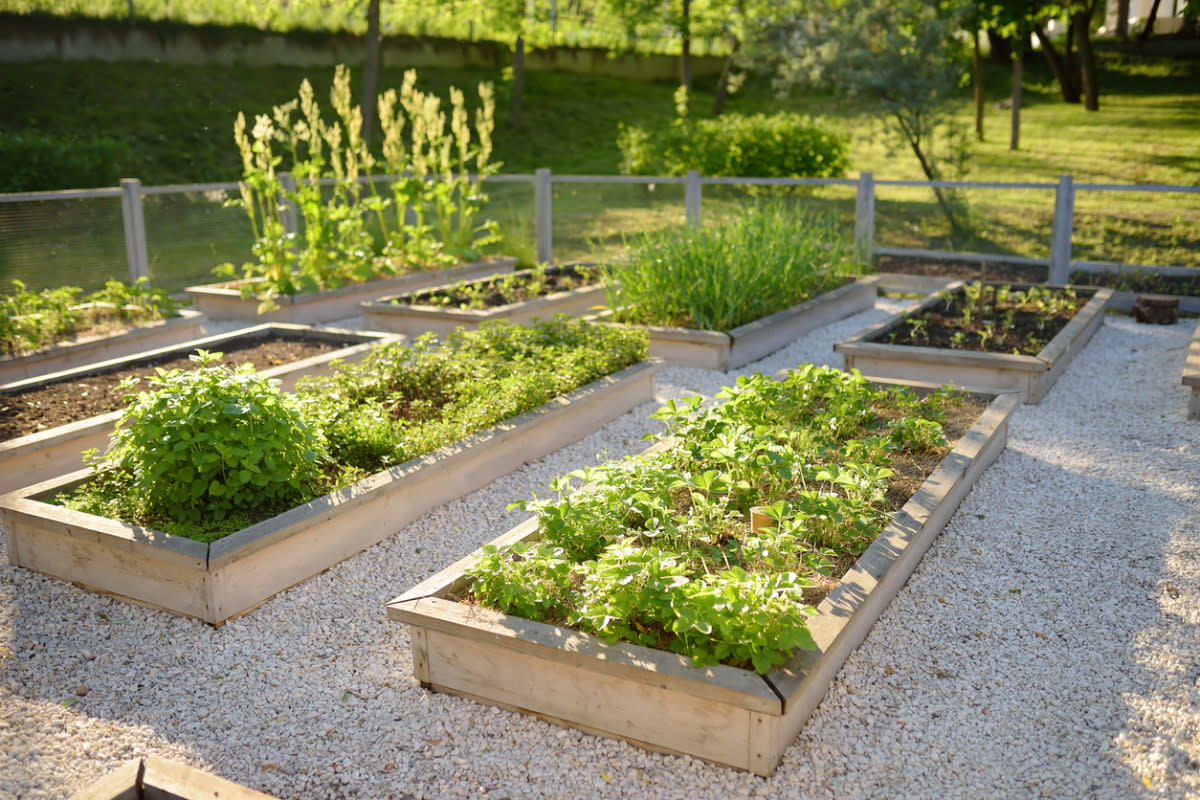
Raised garden beds
Ready to take things outside? You're not alone. Houzz research shows that 50% of homeowners are putting dollars and cents toward improving outdoor spaces, and many are looking for ways to incorporate sustainability into their living spaces (yards included). Enter the raised garden bed.
Back up—what is a raised garden bed anyway?
"A raised garden bed is a planting bed that has been raised a few inches off of the ground by using a bordering material and filled with soil," says Diane Kuthy, the founder of How To Grow Everything.
There are pros and cons to using elevated garden beds, and plenty of inexpensive, DIY, repurposed and modern looks to choose from. These 35 raised garden ideas showcase many pros, from function to style.
Related: 45 Most Common Houseplants to Grow in Your Space
What Is a Raised Garden Bed?
"A raised bed can be a lot of things," says Sara Abbass of Sara Mairead Landscape Design. "Raised beds can take many forms...They all have one thing in common—they are planted above ground, where you have control over the soil selection and mixture."
These forms may include a 12-inch tall cedar bed on a patio or a raised planting bed. Abbass says the size of the yard and goals will determine what to plant in the bed.
Related: 16 Different Types of Edible Flowers You Can Add to Your Garden
Pros and Cons of Raised Garden Beds
Soil quality control is the most significant benefit of a raised garden bed. "You can easily add amendments and fertilizers and control the pH and quality of the soil in a raised garden bed because they are beds in which the soil is contained," Kuthy says. "With in-ground planting, it can be difficult to amend the soil to the ideal conditions as the materials used can be easily absorbed by the surrounding soil or washed away via erosion."
Your plants may also be more protected from pests like gophers.
"You can line the underside of your bed with wire mesh, which prevents their access," Kuthy explains. "Additionally, by lining your garden bed with landscape fabric before filling with soil, raised garden beds also prevent weeds from taking over your garden."
An underrated perk? Your back will thank you.
"We don’t have to bend over for our veggies if we don’t want to," Kuthy says. "A raised space allows us to choose our location and full accessibility as we see fit for our needs and [makes it] easier to weed."
The big con is the cost.
"Raised garden beds are much more expensive compared to in-ground gardens," Kuthy says. "Also, your gardening space is limited by the size and shape of your raised garden bed."
Related: 40 Best Spring Flowers to Beautify Your Backyard, According to Gardening Experts
What Do I Put on the Bottom of a Raised Garden Bed?
According to Kuthy, you can typically skip underlayments if your raised garden bed sits on top of rock or concrete, but sometimes you'll need something. "I like to line my raised garden beds with a layer of wire mesh to prevent rodents like voles and gophers from tunneling under the beds," she says. "I also line the bottom of my raised beds with landscape fabric to prevent weeds from growing up into my garden."
Related: 35 Magical Fairy Garden Ideas To Enchant Your Backyard
35 Best Raised Garden Bed Ideas
1. Clean and classic
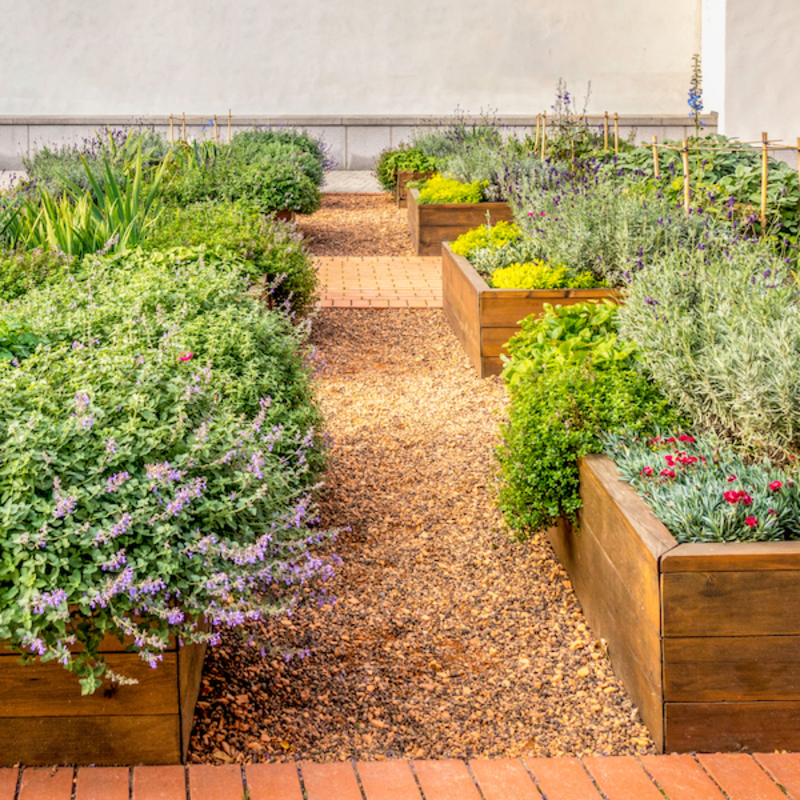
How to Grow Everything
Kuthy says cedar is a popular design for raised garden beds and for many good reasons.
"Cedar wood is a beautiful, natural and long-lasting non-toxic material that creates a clean and classic look," Kuthy says. "You can create any shape you'd like, but most people go for the standard square or rectangular look."
Related: Got a Green Thumb? Get Ready to Give This ‘Monstera’ List of Plant Memes a Big Thumbs Up
2. Concrete jungle
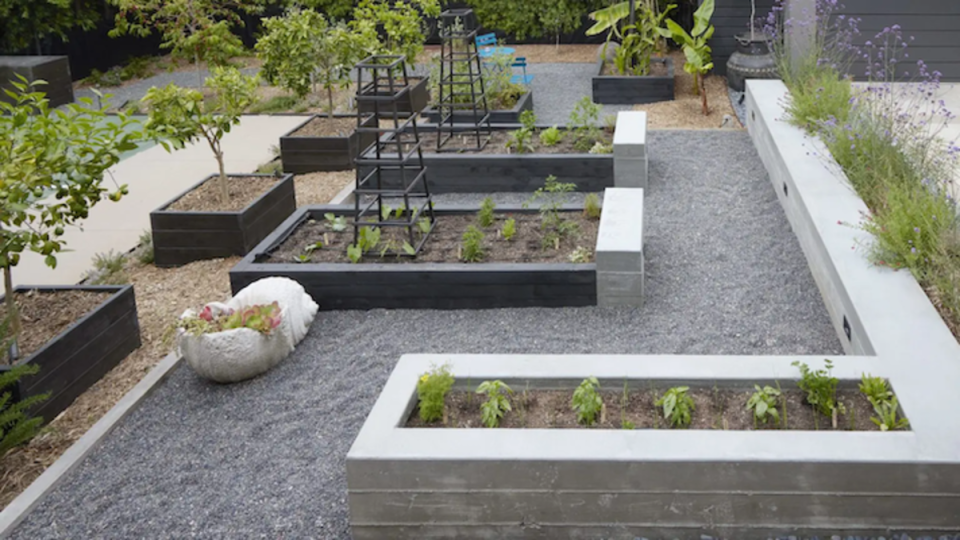
Farmscape
Concrete is another popular design for a garden bed for its fuss-free function (still allowing for style).
"Board-formed concrete beds like these are durable, beautiful and wide enough to double as convenient seating while gardening or casually sitting in the garden while talking with friends," says Dan Allen, Farmscape CEO and co-founder and a master gardener.
3. Growth mindset
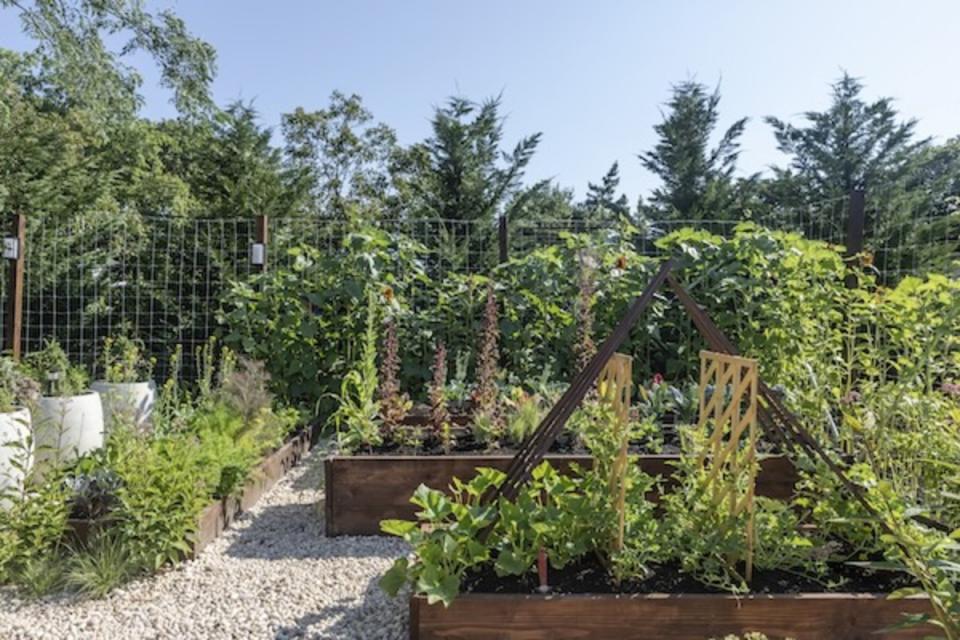
Photographer Michele Scotto
Abbass worked with Chef Rob Chiappone to custom-build this garden with raised beds at various heights. The inspiration is super sweet (and not just about growing veggies).
"The clients envisioned accessible areas for their children as they grow," Abbass says. "Pine was the selected box material for this project, based on budgetary considerations. The ground of this garden was layered with pea gravel to manage drainage and weed control."
4. Cityscape
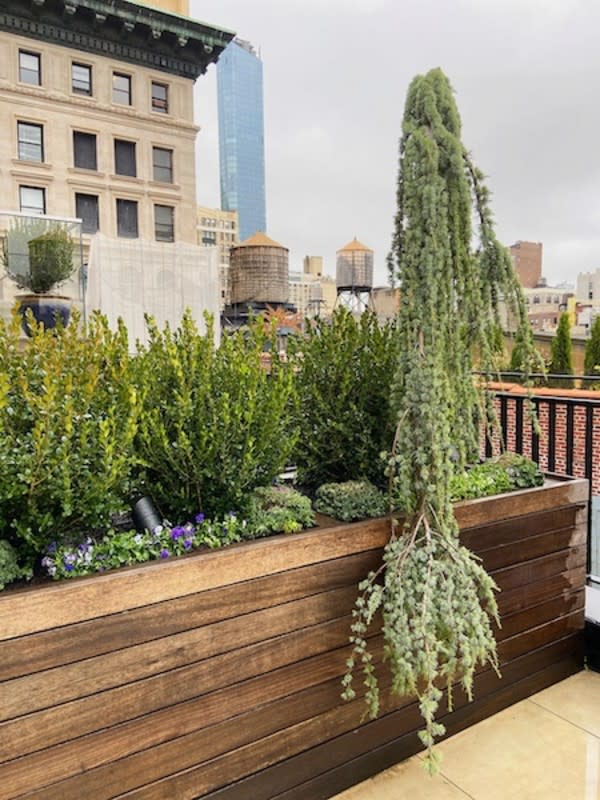
Amber Freda
How cool does this design look when juxtaposed against a skyscraper? Raised beds are clutch for urban gardeners.
"Raised beds offer a lot of flexibility in terms of what you can grow and greater control over the quality of the soil, says Amber Freda, who founded her own garden and landscape design business in 2004. "For the container gardens we design and install in NYC, we use potting soil that drains well and also retains enough water to keep the plants from drying out."
5. Don't limit yourself
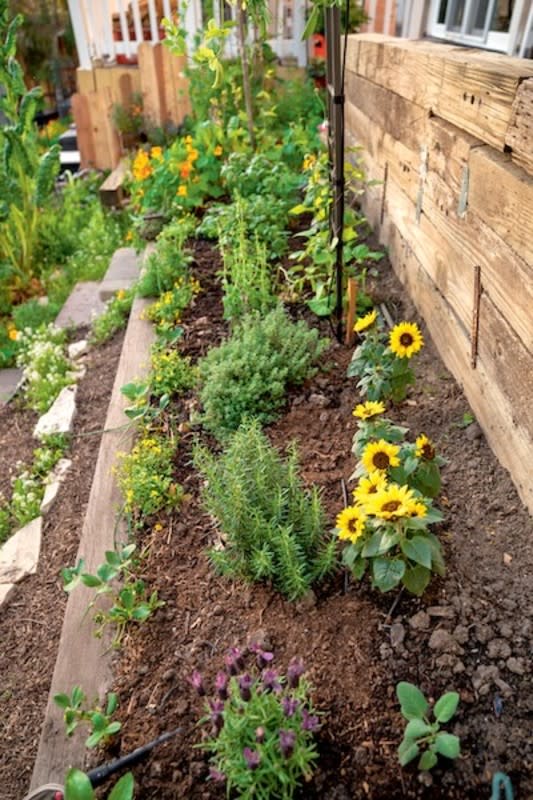
Photographer Jerry Hooper
Raised garden beds literally aren't one-size-fits-all and can be made from so many materials.
"The options are limitless," says CaliKim of YouTube’s CaliKim Garden and Home, author of The First Time Gardener: Raised Bed Gardening and Organic Gardening for Everyone. "They aren’t limited to square or rectangular shapes. They can be round, octagonal, Y-shaped or triangular."
And you don't have to separate herbs and flowers. Here, a raised garden offers a multi-sensory experience courtesy of plenty of fragrant herbs and happy-go-lucky sunflowers.
6. Modular mode
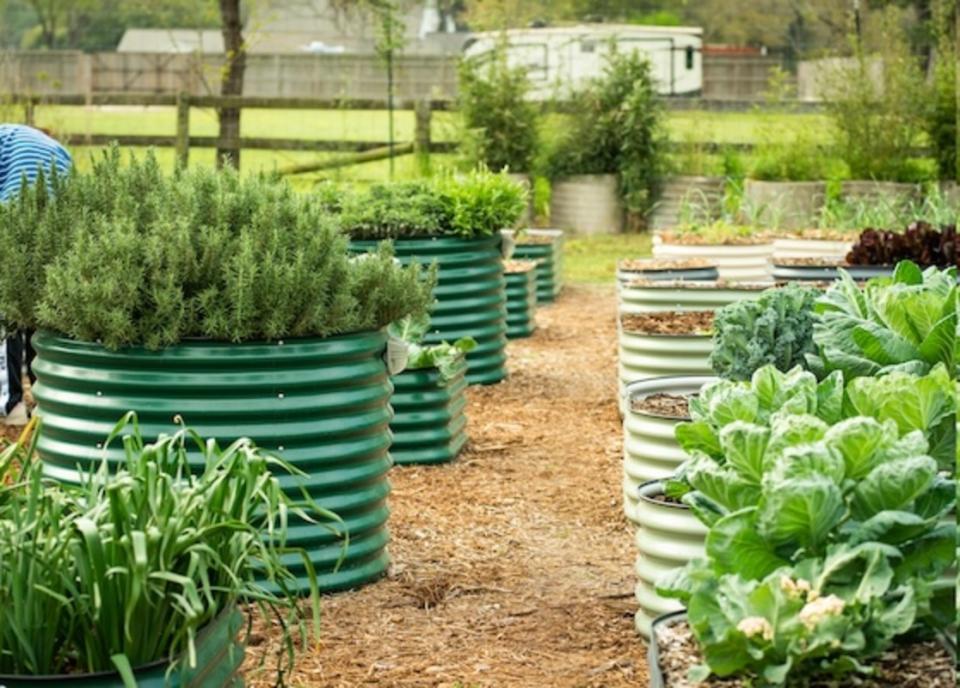
Vego Garden
The modular design of this garden bed allowed Naomi Shen of Vego Garden to use various configurations, allowing for a custom fit to the space. Easy assembly made gardening feel more like a pleasurable pastime than a chore—as it should be.
Related: 35 Funny May Memes About Spring Flowers, Allergies and the Weather
7. Strategic placement
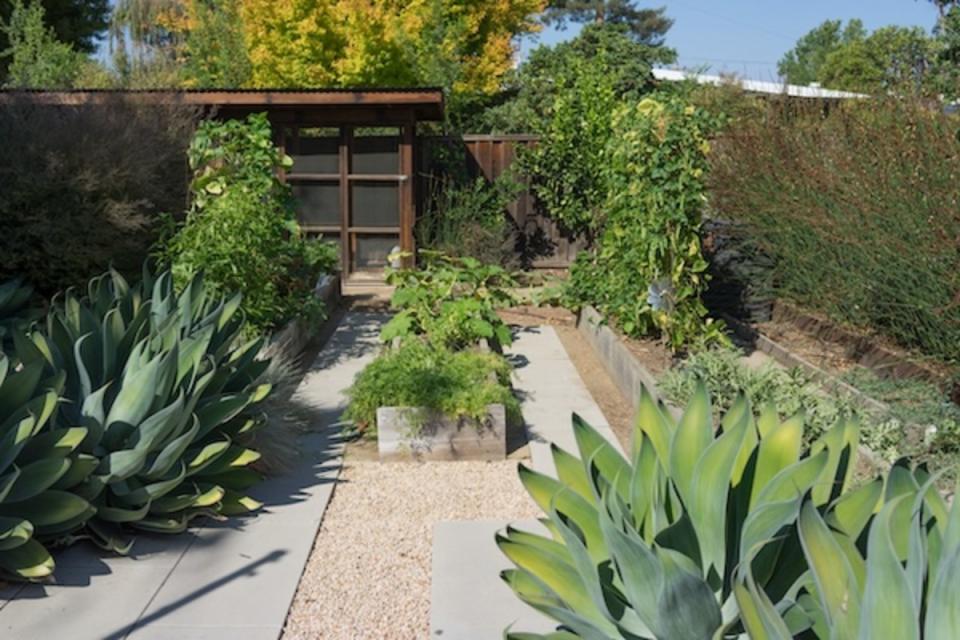
Photographer Hoi Ning Wong | Houzz
The landscaping pros at Houzz recommend strategically considering where to place your garden bed. Sure, you want optimal sunlight, but accessibility is important. For instance, putting a garden bed near a kitchen window might serve as a gentle reminder to water your plants, says Annie Thornton, Houzz outdoor design expert.
8. Blockhead
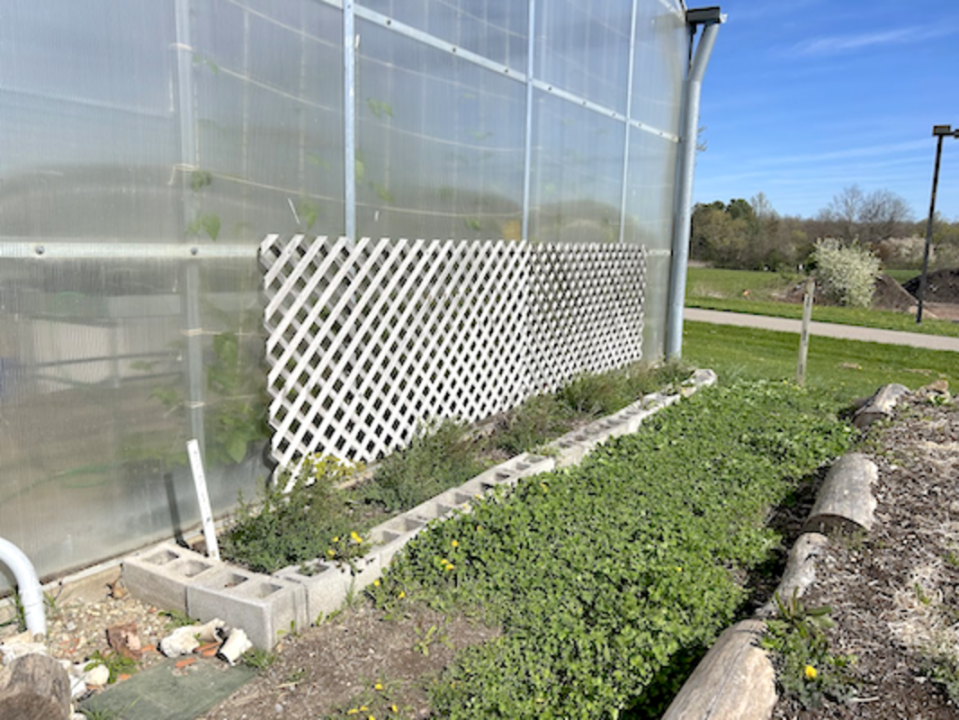
Courtesy Sarah Warner
Again, garden beds can be simple and inexpensive. Sarah Warner loves how cinder blocks worked in this perennial medicinal raised bed. Do you know what she loves even more? How accessible cinder blocks are, even second-hand—a way to potentially save on what can become a pricey venture.
"Cinder blocks are easy to come by, especially on Facebook Marketplace or other free websites or applications," says Warner, the greenhouse manager at the Case Western Reserve University Farm at Case Western Reserve University. "This is an excellent and achievable bed for any homeowner or renter. The cinder blocks do a great job of keeping the soil and mulch inside the structure and can prevent the spreading of plants."
9. Layered looks
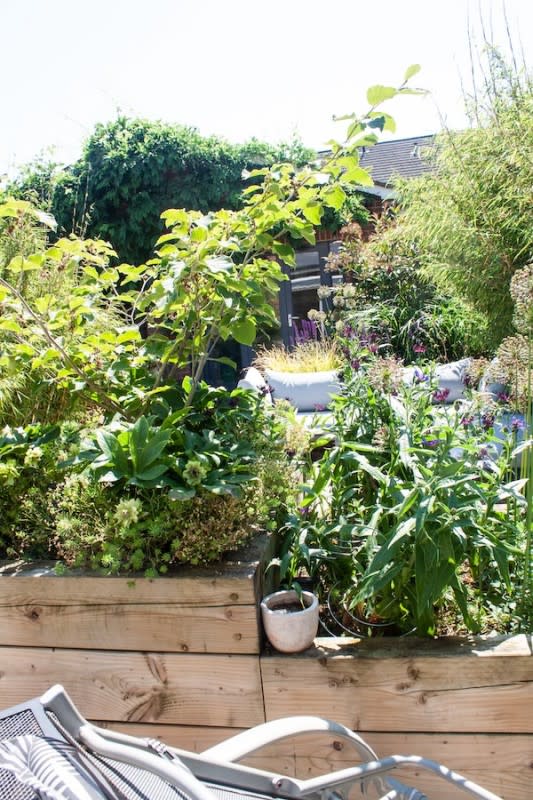
Hine Garden Design
Spring and summer weather may require less clothing layering, but Amber Hine, the garden and landscape designer behind Hine Garden Design suggests creating layers and a dynamic space for a bed.
"The use of different levels creates a richly textural layered effect to the planting and...an abundant feel with a sense of vastness in an otherwise compact space," Hine says.
10. Base camp
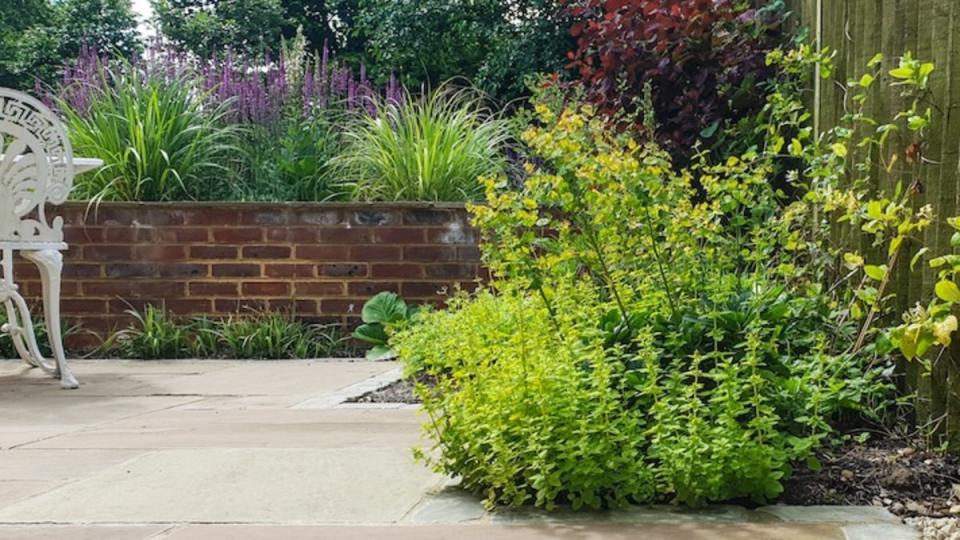
Hine Garden Design
Hine also loves using raised beds as a backdrop to ground-level planting.
"Don't forget to plant at the base of your raised beds," Hine says. "Using the vertical plane from your raised planting allows you to soften the raised beds and create dramatic effects of texture and form with some supplementary planting."
11. Cover up
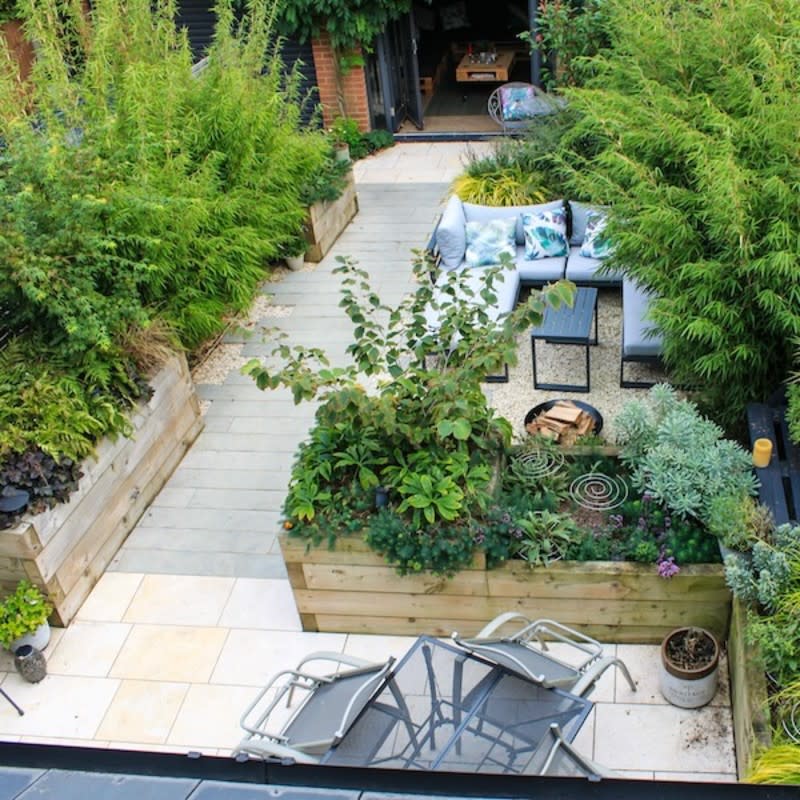
Hine Garden Design
One of Hine's favorite tricks is to use raised garden beds to disguise or hide certain features of a space you need but would rather not see.
"All houses have features that we may wish to disguise, and a raised bed is perfect to hide a feature that detracts from the garden environment," Hine says. "Such features are important. However, effectively disguising them allows you to be better enveloped by the garden [and] immersed in that natural environment itself."
Pssst...in this photo, Hine reveals, "The air conditioning unit is on the right behind the raised beds."
12. Set boundaries
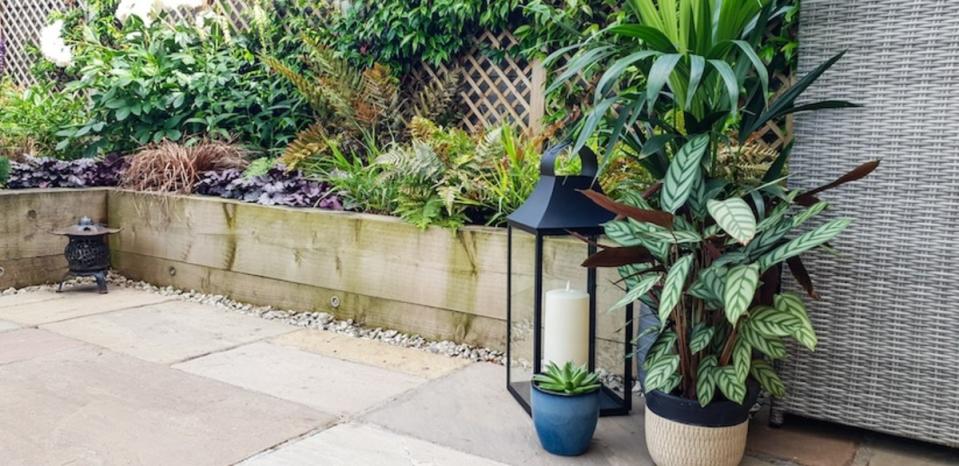
Hine Garden Design
Hine loves using garden beds to create individual—yet cohesive—spaces in a garden or outdoor area.
"The spaces in this garden flow together well," Hine says. "Although none are overly obscured or separate, the raised beds help to create a soft sense of boundaries and foster identity and purpose for each area. Creating a purpose in your garden and clarity in your space is so important."
13. Let the garden lead
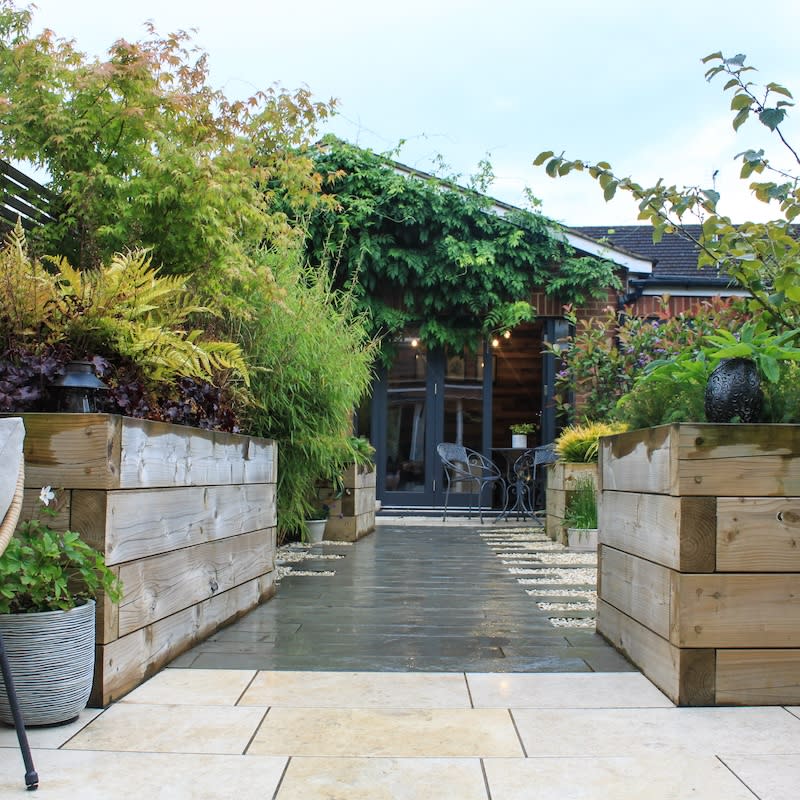
Hine Garden Design
Hine loves how the raised beds work with hard landscaping elements in this garden, creating a clear way to move about and explore this outdoor space at a summerhouse destination.
"Raised beds can help guide and direct you through a space, encouraging you [to walk] through to other areas of the garden, creating entrances and lining pathways," Hines says.
14. All that meets the eye
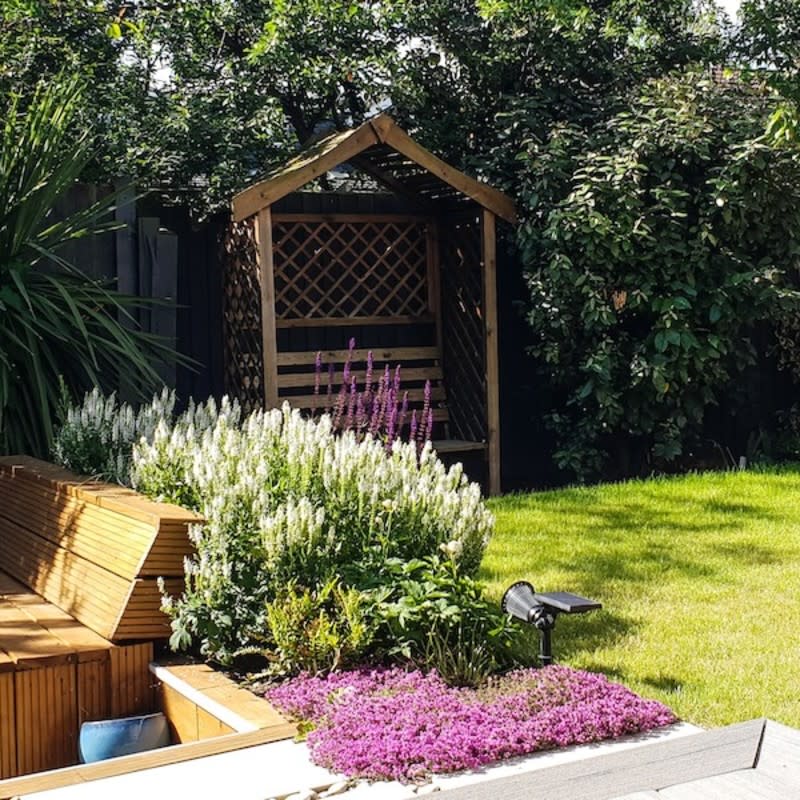
Hine Garden Design
Raised plants allow you to ensure the beauty of your garden is right in front of you when you place plants at eye level.
"Feel a sense of emersion with planting that surrounds you, bringing blooms, texture and movement in a breeze to your enjoyment of a garden space," Hine says.
15. Breaking up is (not so) hard to do
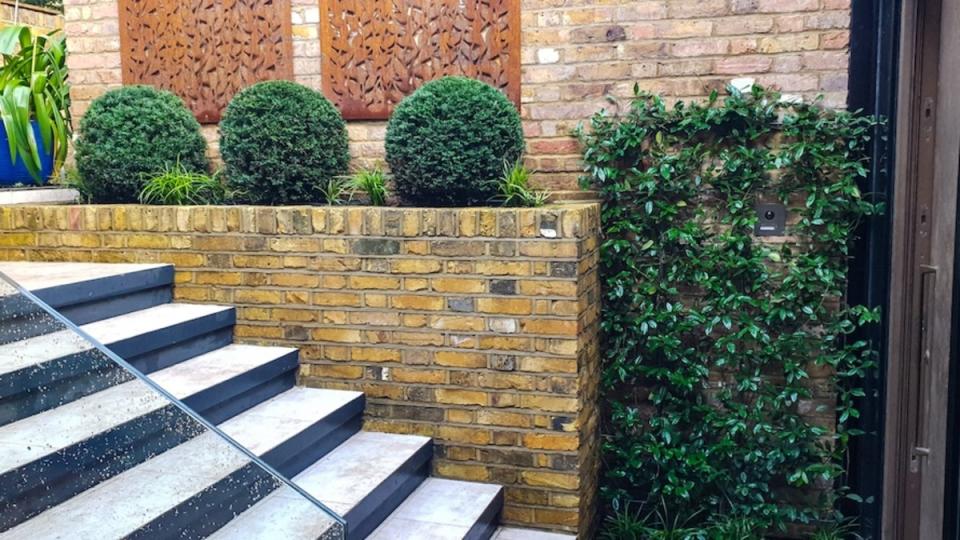
Hine Garden Design
Hine also adores using beds to break up wall space and create visual interest.
"Raised beds are used here to create a natural planting break in this tall wall and provide a pseudo handrail," Hine says. "The natural stopgap gives your eyes a visual break, reduces sound bouncing off hard surfaces, and gives you something to rest your eyes on and enjoy other than a wall of bricks—lovely though they are."
16. Red brick road
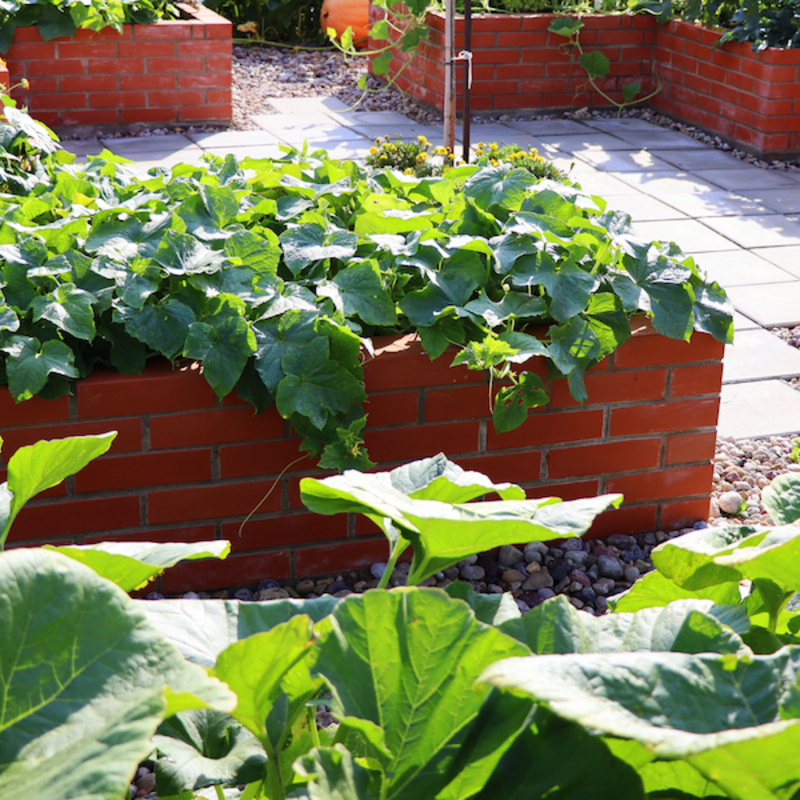
How to Grow Everything
Speaking of bricks...
"I love the look of red brick raised garden beds," Kuthy says. "First, these beds are surprisingly easy and cost-effective to make and will last a lifetime as brick does not deteriorate like wooden garden beds. They look wonderful built up against a home that also has a red brick facade or on their own in a garden space."
17. Rock out
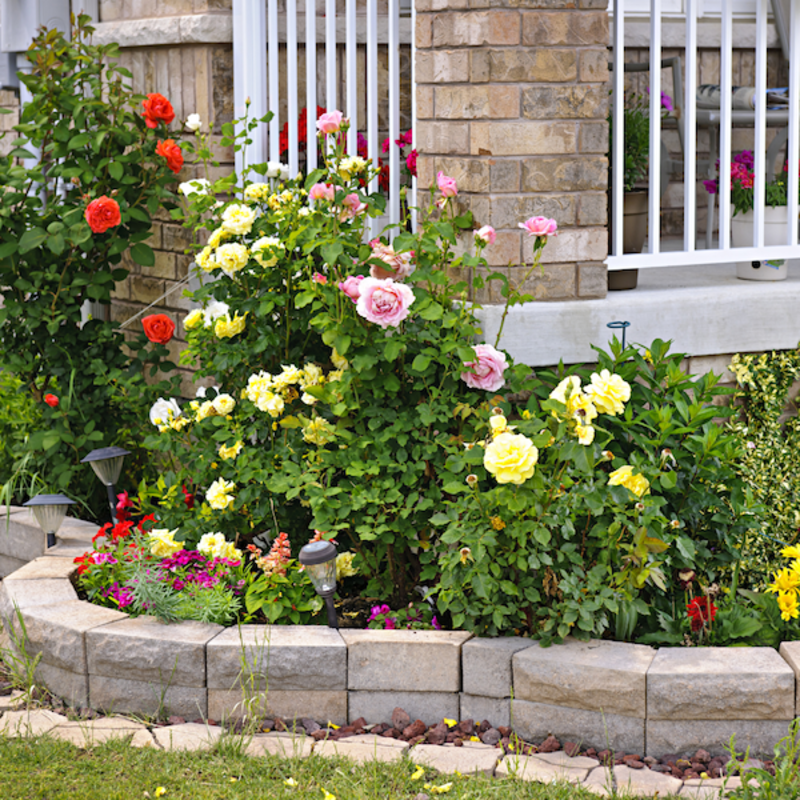
How to Grow Everything
Bricks not your style? Consider stones.
"You can use retaining wall stones as seen in this image or use boulders, rocks and other stone material that better matches your desired look," Kuthy says. "The great thing about stone is that it has an infinite life, so you won't have to worry about replacing these beds in seven to 10 years like you do with their wooden counterparts. This is my ideal choice when designing landscaped beds around a home with stone siding or accents."
18. Tiering up
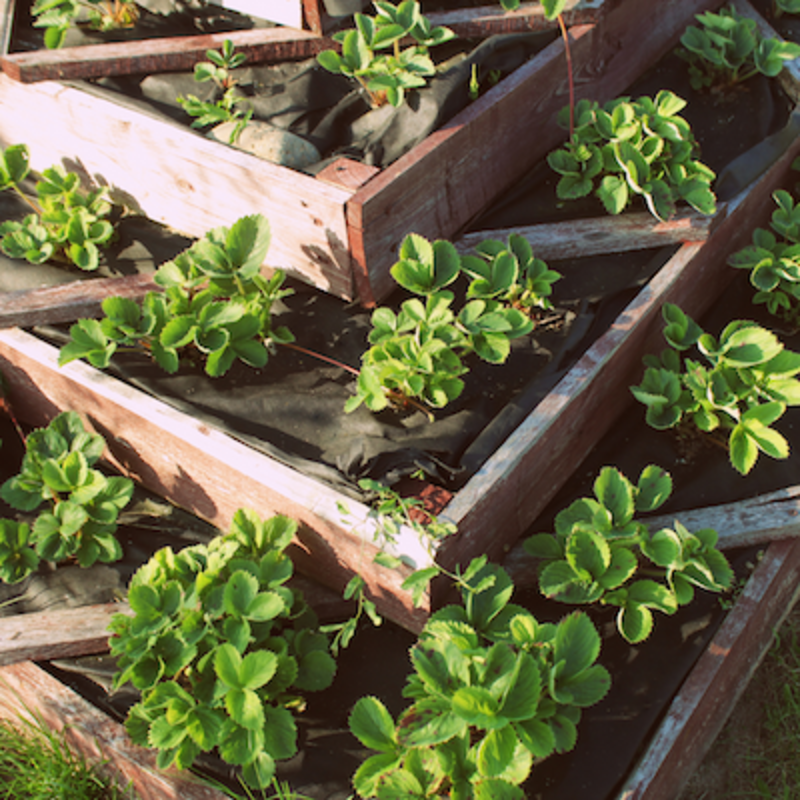
How to Grow Everything
Another vote for using levels to create layers! This design from Kuthy has more of a stacked or pyramid-style look than Hine's design in No. 9.—but both are gorgeous and clever.
"Tiered beds add a wonderful element of height to your garden and can be used to create a flowing flower bed or garden bed," Kuthy says. "I love them because they help to create different levels within a garden that is pleasing to the eye line."
19. Logging out in a bold way
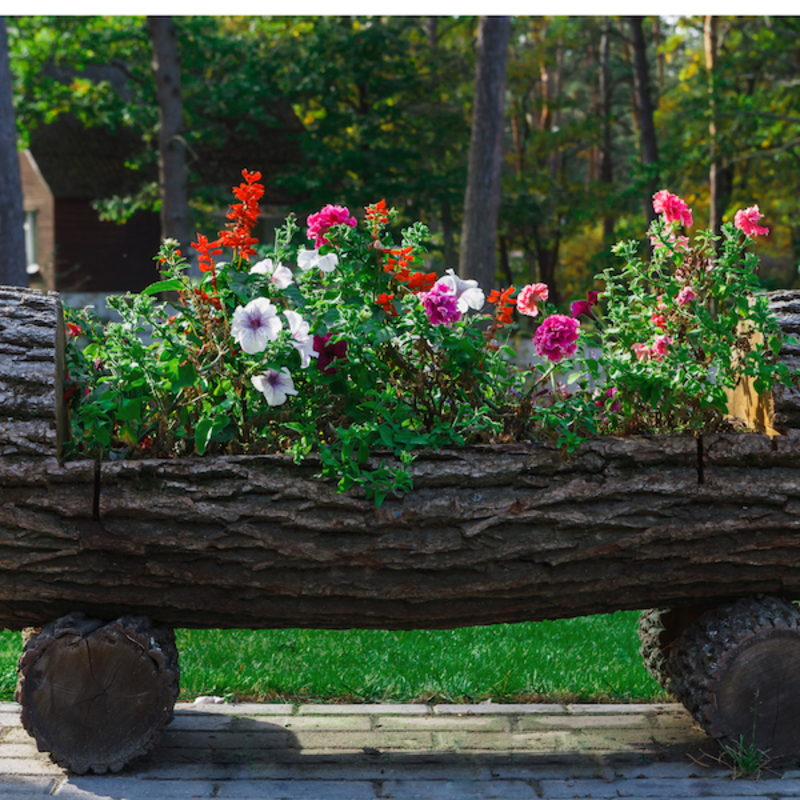
How to Grow Everything
Want to get super creative?
"This raised garden bed is cut into an old log, which makes it a natural, inexpensive, and super whimsical option as a garden feature," Kuthy says. "It adds playfulness and fun to a garden space while still keeping a natural theme."
20. Logging out subtly
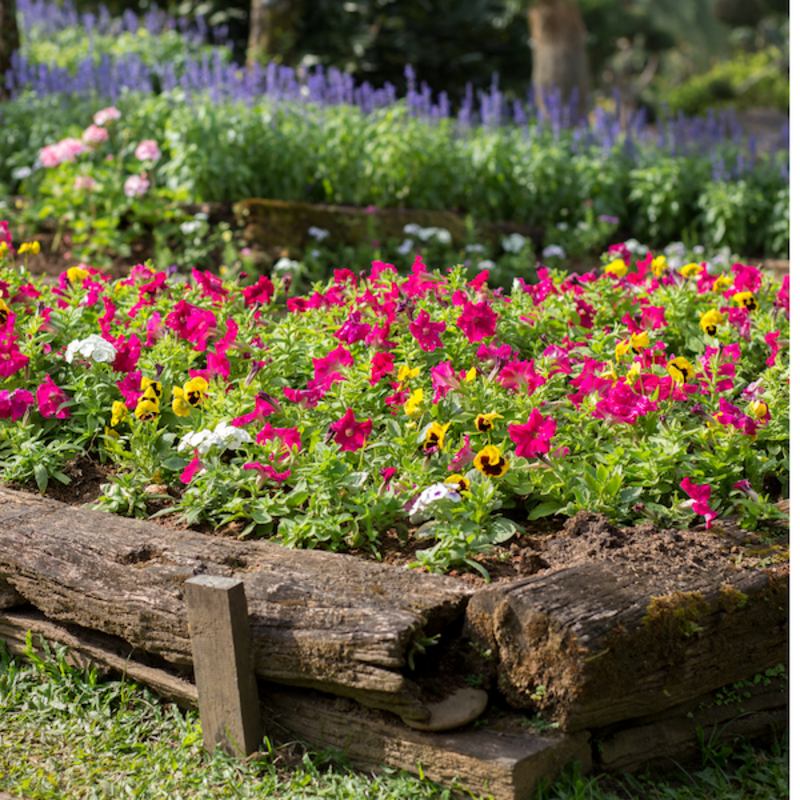
How to Grow Everything
"If that last garden bed option was too wild for your taste but you also love the idea of using raw natural materials, then you can simply use rough logs to frame a classic rectangular garden bed," Kuthy says. "This has a more rustic 'cottage garden' look that works well for less manicured garden spaces."
21. Raised garden bath
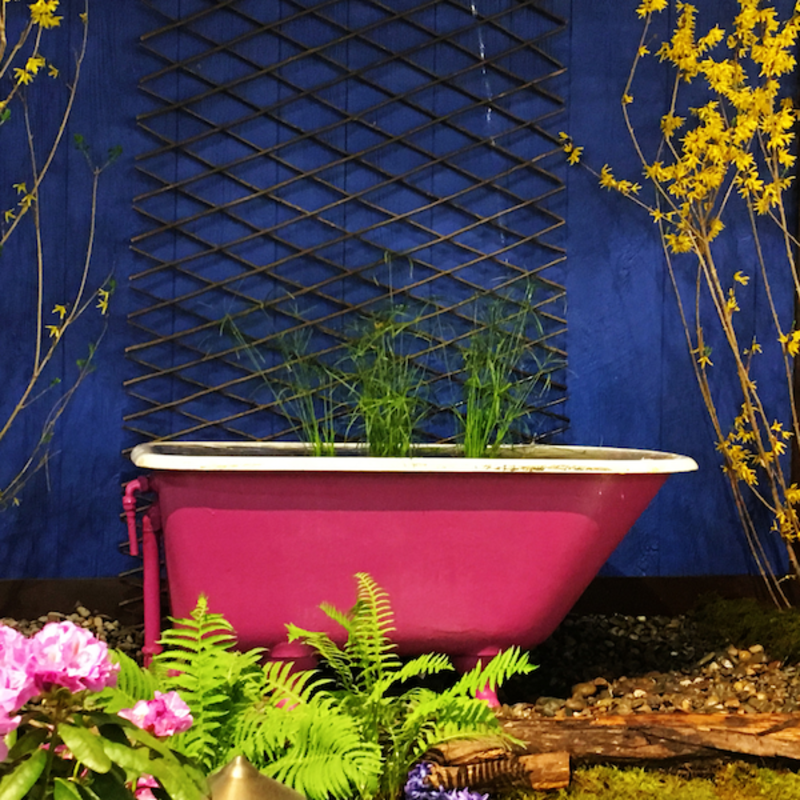
How to Grow Everything
Feeling thrifty and creative?
"Old claw-foot tubs make fantastic raised garden beds," Kuthy says. "They are the definition of whimsical and long-lasting, and most can be acquired for next to nothing at a garage sale. You can paint them any color you'd like—even dark greens for a more natural look—and plant anything in them, from flowers to large trees."
22. (Don't) kick the tires
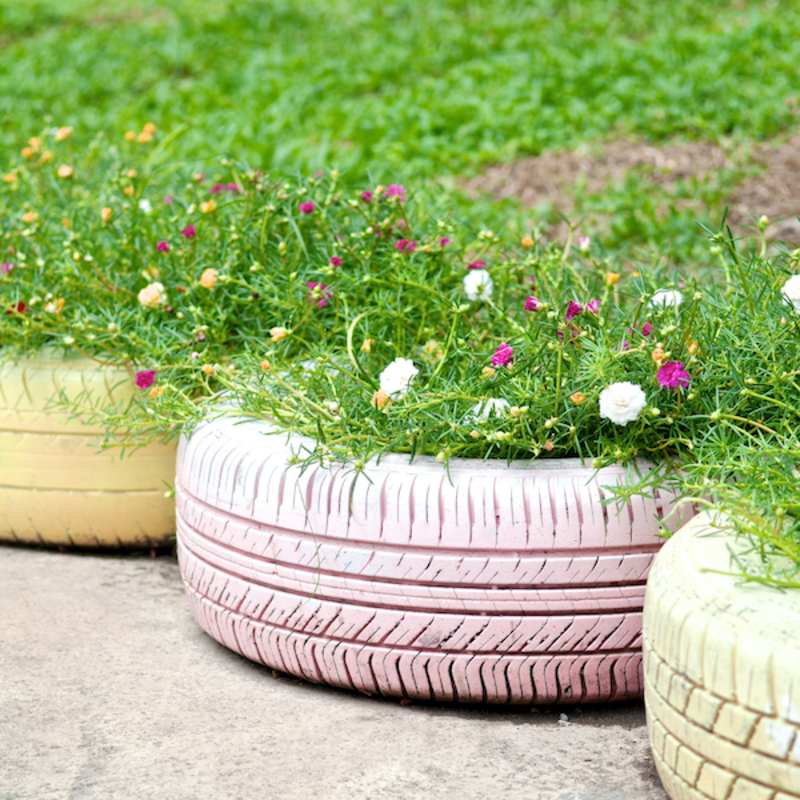
How to Grow Everything
Instead of ditching old tires, repurpose them.
"Old rubber tires are another fun trash-to-treasure-style raised garden bed design that I love," Kuthy says. "While rubber tires are not the best materials for vegetable gardens, as they may leach chemicals you don't want in your food, they are perfect for accent flower beds. Tires can be painted in a wide variety of colors to transform their industrial look to something more subtle, like these pastel-painted beds."
23. Bike basket
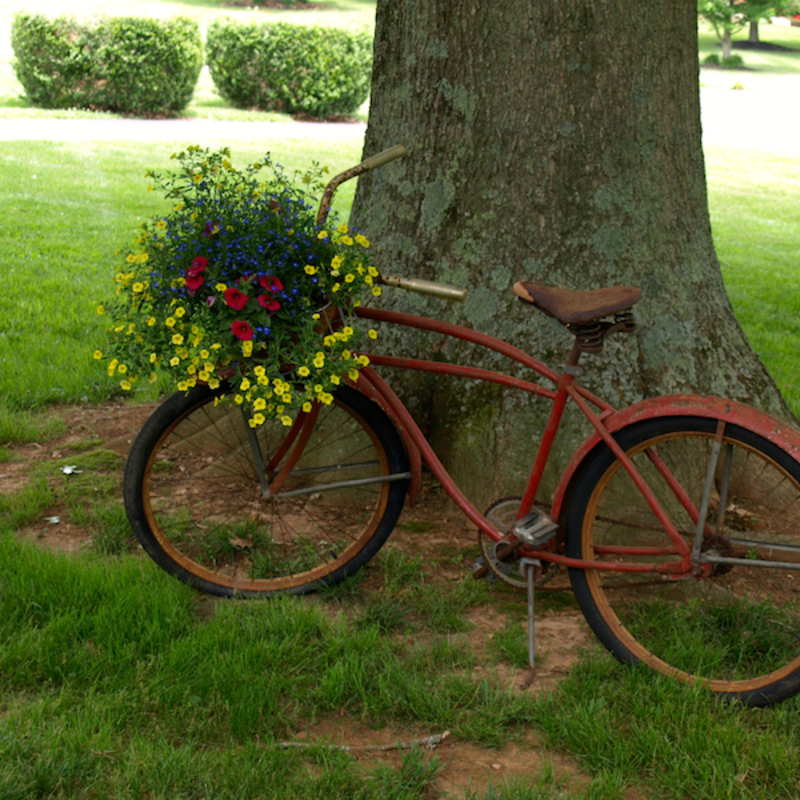
How to Grow Everything
Kuthy says this one might seem "out there." However, she also says, "I just like to drive the point home that almost anything can be used as a raised garden bed."
That includes an old bike with a basket.
24. The flowers called fives
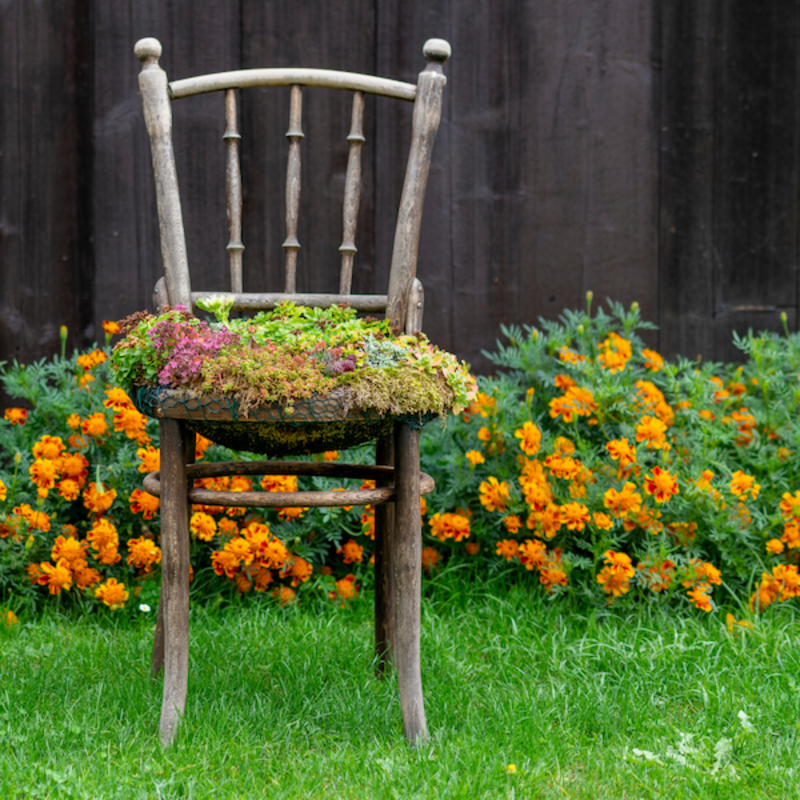
How to Grow Everything
Like an old basket, "an antique chair can be easily transformed into a really unique garden feature that is also quite functional," Kuthy says. "I love adding these eye-catching garden features in moderation around a garden space."
25. Stock rising
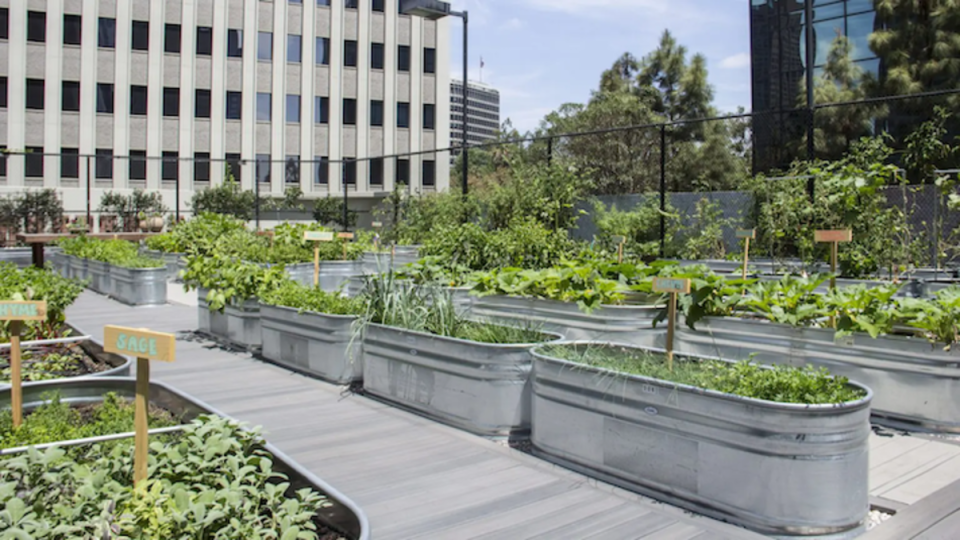
Farmscape
This Farmscape project marks another stellar example of repurposing something old for a garden bed.
"These planters are converted from their designed use as water troughs by drilling them for drainage and adding a couple of inches of drainage rock at the bottom," Allen says. "Stock tanks come in a variety of sizes, and primarily in oval and circular shapes. We love how they look in the right setting, like this downtown LA rooftop."
26. Cool and curvy
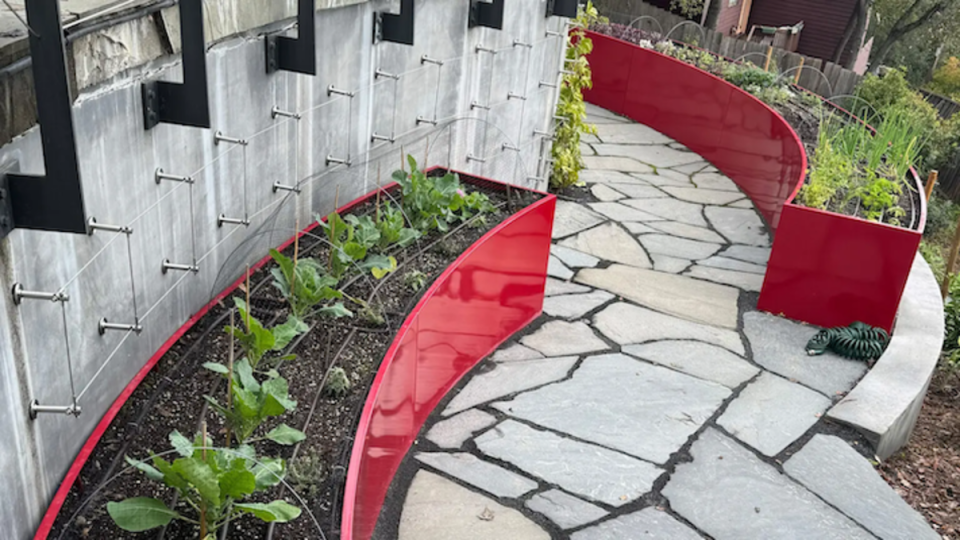
Farmscape
"Most raised beds are built with materials that require straight lines—not so with these custom, curved planters, which we designed to follow the lines of a preexisting concrete wall," Allen says. "The result is one of our most unique installations to date and an abundant garden on a previously underutilized hillside."
27. Plot for winter gardening
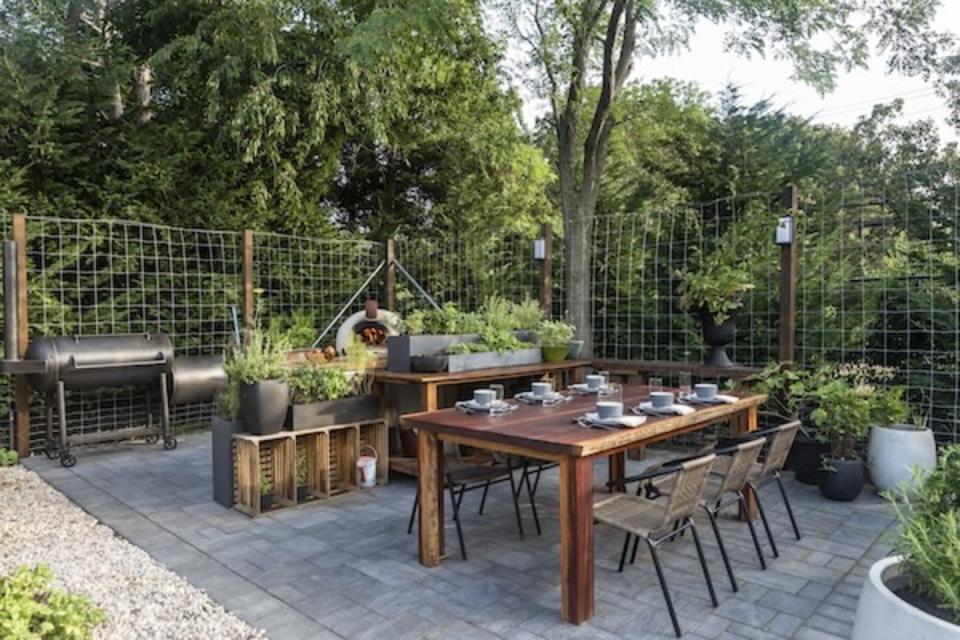
Photographer Michele Scotto
Abbass teamed up with Chef Chiappone to create this raised garden bed for herbs.
"Many herbs can overwinter outside, so being able to have accessibility to your herb plantings is a must," Abbass says. "We used galvanized metal and clay pots for many of the herbs in this photo."
28. Start small
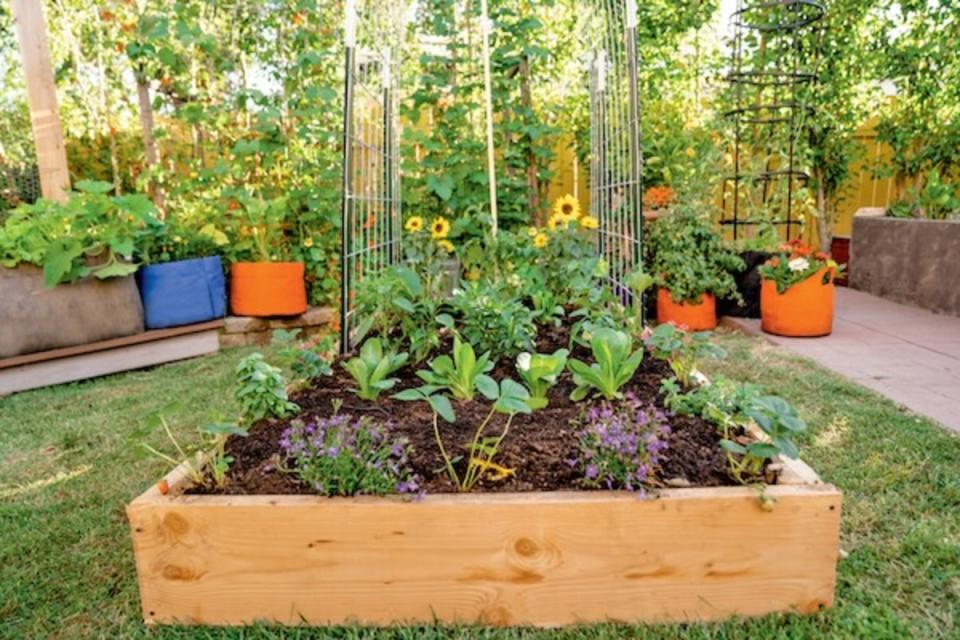
Photographer Julianne Hooper
If this year marks your first attempt at using a raised garden bed, consider opting for a beginner-friendly kitchen layout.
"A manageable size is 4-by-8 feet, but adjust it to your available space," CaliKim says. "Start simple with this first bed and then expand later as you gain confidence and experience."
She suggests planting daily favorites like herbs, greens, tomatoes and peppers in the garden.
"Arrange the tallest plants in the back and the shortest in the front to avoid shading," she adds. "Grow vining vegetables up a trellis to maximize space, plant fillers like beans, greens and herbs in the middle, and spillers like zucchini and strawberries along the edges."
29. Happy returns
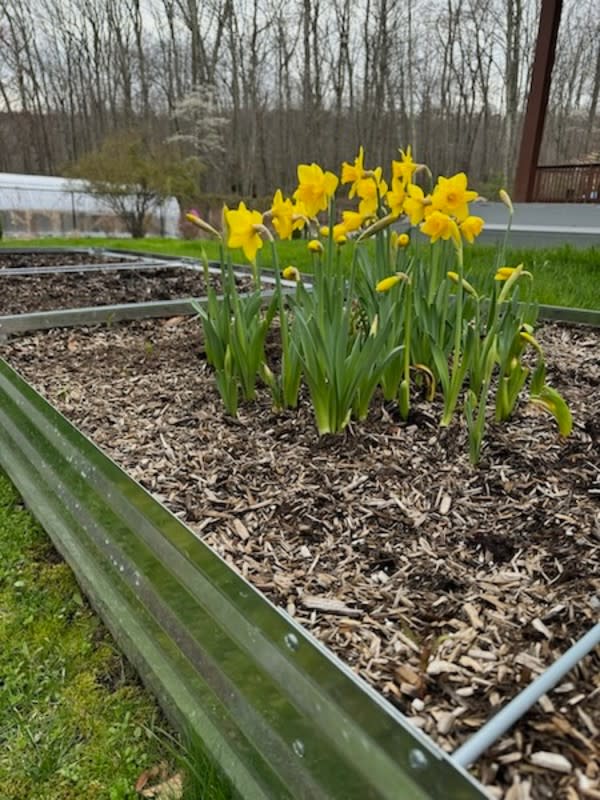
Amber Freda
Some flowers are more fuss-free than others.
"I like to plant bulbs like daffodils and tulips in raised beds because I can use bagged potting soil, which is a lot easier to dig holes into than regular garden soil," Freda says. "This allows me to dig a single large hole very easily, which I put all my bulbs into in the fall and am rewarded by masses of cheerful-looking flowers each spring."
30. Keep it contained
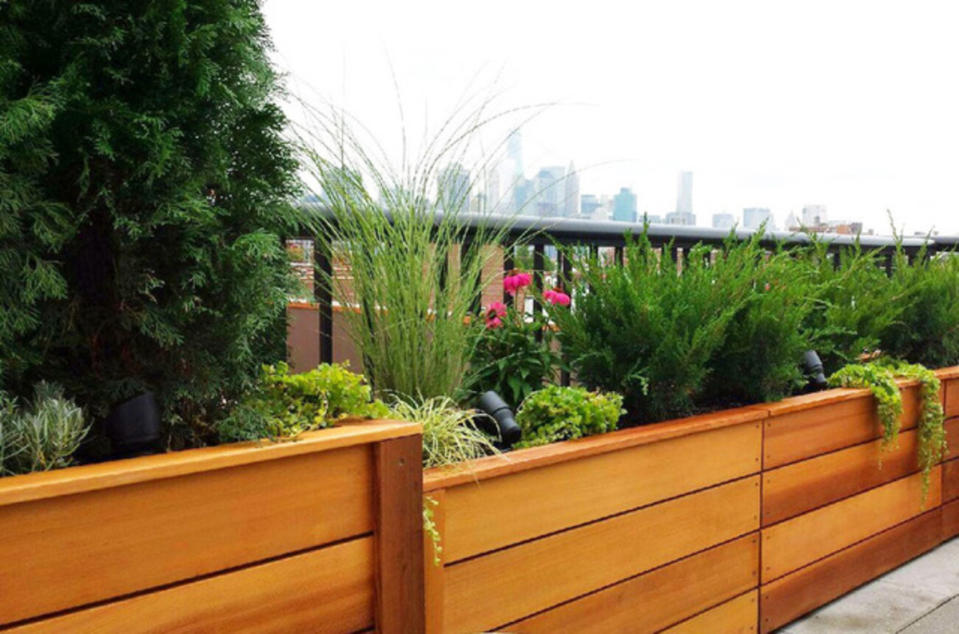
Amber Freda
Freda commonly uses container gardens with her city-based clientele.
"The container gardens we design and install in NYC are also a form of raised beds, which allow us to grow plants on rooftops or rocky backyards, where it would be impossible to garden otherwise," she says.
31. Small and sweet
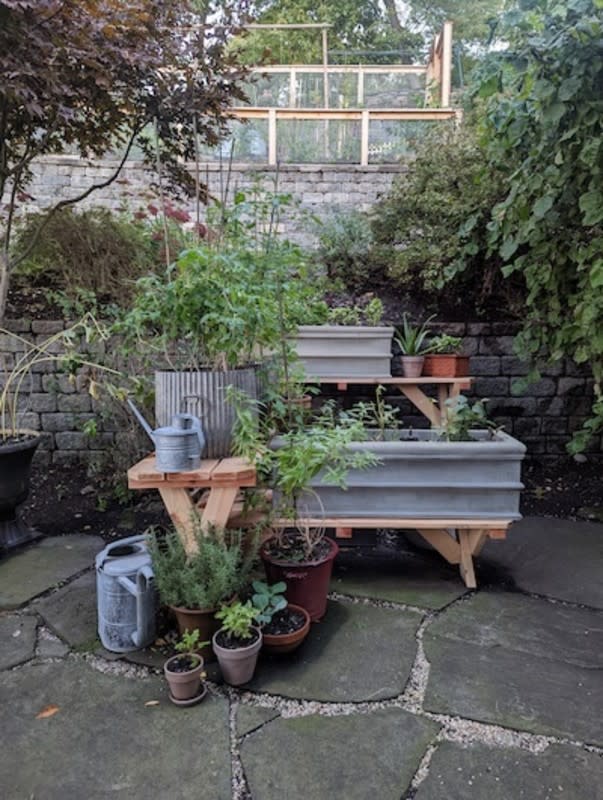
Photographer Ricky Robertson
Small space? No worries—a raised garden bed is still on the table (and so are delicious dinners, thanks to this idea provided by Abbass, who got an assist from Chiappone again).
"This sweet kitchen herb garden was the perfect setup for accessibility," she says. "Utilizing several planters already present, we added planters with at least 18 inches in depth to account for the desire to grow tomatoes closer to the kitchen. Customized cedar benches were designed to accommodate the container gardening space."
32. Multi-functional
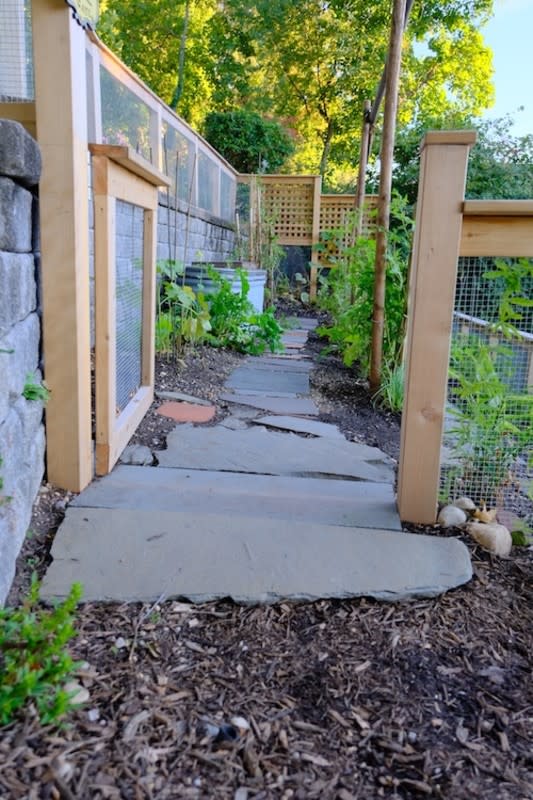
Photographer Ricky Robertson
Abbass and Chiappone teamed up for this one, which combined raised bed and in-ground planting with an eye to the future.
"The design incorporated a tin tub that would be used for worms, potatoes and...future compost needs [for] the ground plantings," Abbass says. "Here, we incorporated a smart way to continuously have quality soil to add to the ground plantings."
33. Drainage designs
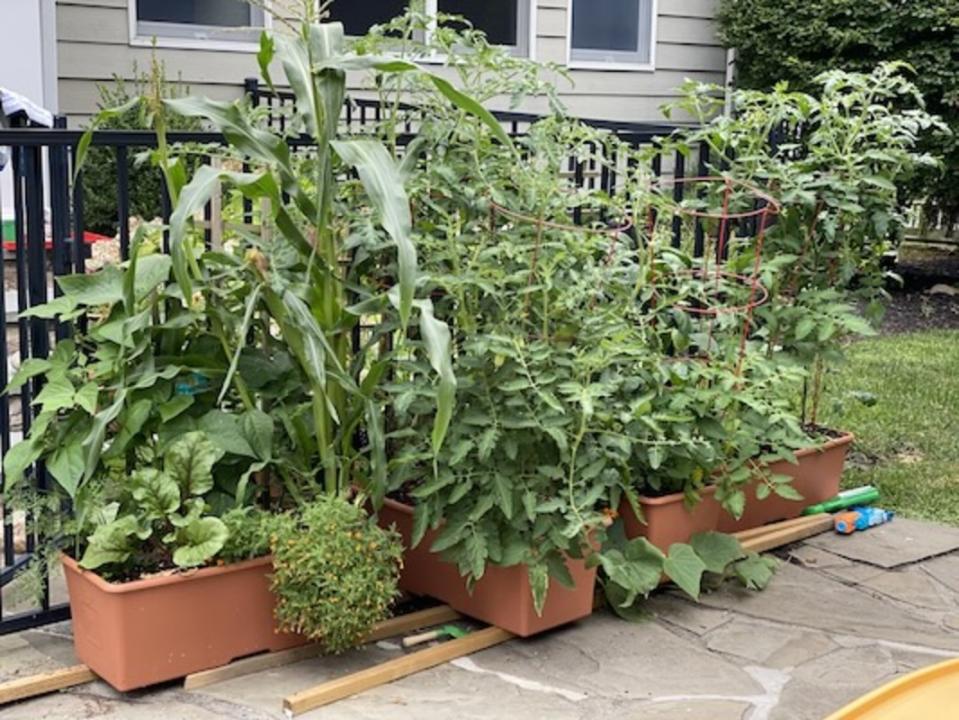
Photographer Sara Abbass
"Another great option for a small space [are] the EarthBox raised beds," Abbass says. "These planters come with drainage and encourage watering from the bottom to ensure the root systems properly soak in the irrigation. They are designed to allow for multiple plants in each planter. Container gardening on a patio or balcony is a lot easier with planters like these."
34. Going solo
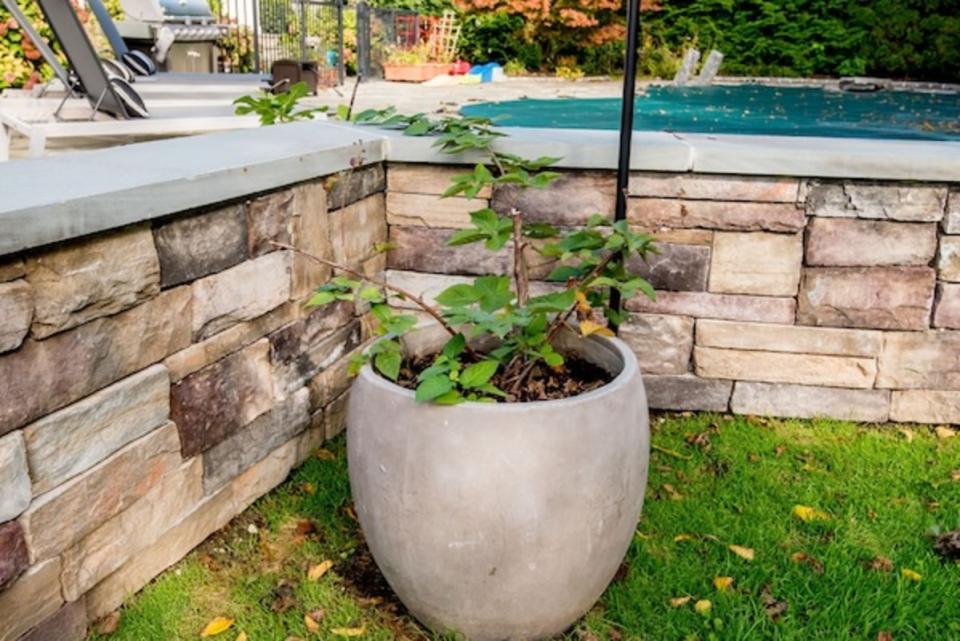
Photographer Vera Chwostyk
While multiple beds are ideal for some, they aren't necessary.
"Container and raised bed gardening is sometimes just one planter," Abbass says. "A great way to incorporate berry shrubs such as blackberries and raspberries is to add them to a planter. These berry shrubs are known for being bullies in a garden, so reducing the space they have to grow will make it a lot easier to manage. You can still expect great yields from these shrubs."
35. Find a way
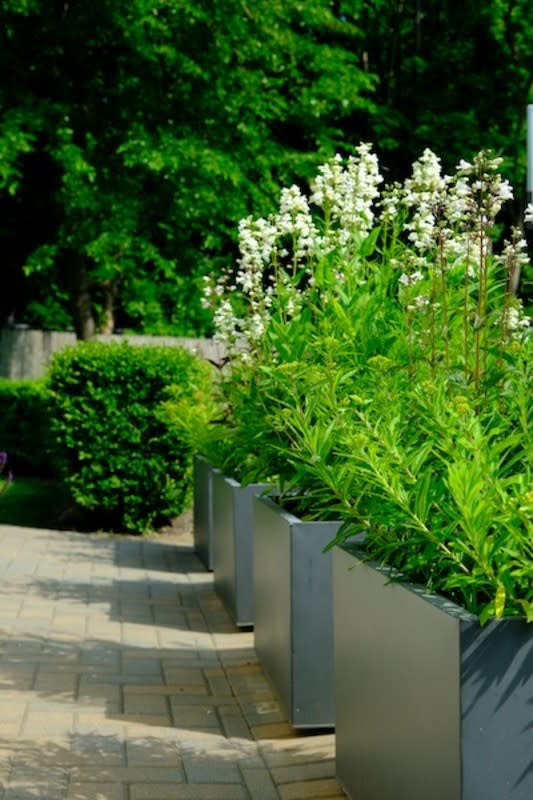
Photographer Ricky Robertson
Can't afford your "dream garden"? Don't let it get you down.
"There is always a solution," Abbass says.
For this project, she used galvanized planters by CB2 with plenty of drainage holes—"a must when considering edible and perennial plantings," she says. Then, she planted herbs, vines, and perennials, which means something is almost always in bloom (even in New York, where Abbass is based).
Next: Cloudy Day? No Problem! 19 Best Vegetables and Plants To Grow in the Shade
Expert Sources
Diane Kuthy, the founder of How To Grow Everything
Sara Abbass of Sara Mairead Landscape Design
Dan Allen, Farmscape CEO and co-founder
Amber Freda, who founded her own garden and landscape design business in 2004
CaliKim of YouTube’s CaliKim Garden and Home, author of The First Time Gardener: Raised Bed Gardening and Organic Gardening for Everyone
Naomi Shen of Vego Garden
Annie Thornton, Houzz outdoor design expert
Sarah Warner, the greenhouse manager at the Case Western Reserve University Farm at Case Western Reserve University
Amber Hine, garden and landscape designer with Hine Garden Design

